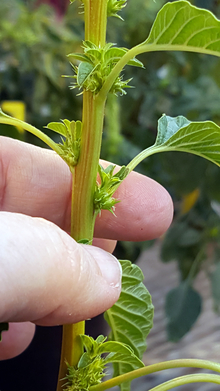Quick facts
Palmer amaranth is an invasive species.
- Palmer amaranth prefers to grow in sunny disturbed areas, row crop fields and has been found in conservation plantings.
- The plant can adapt quickly and build up herbicide resistant genes.
- It is highly competitive, growing up to two to three inches per day in ideal conditions.
Palmer amaranth should be reported. The Minnesota Department of Natural Resources provides detailed recommendations for reporting invasive species.
How to identify palmer amaranth
- Annual plant, commonly six to eight feet tall.
- Rosette has a compact, poinsettia-like appearance.
- There are male and female plants, with males tending to be more slender with a smaller flower head.
Stem
- After bolting, the stem may be very thick, up to five inches in diameter, but most will be thinner.
Leaves
- Oval- to diamond-shaped green leaves are hairless and arranged in an alternate pattern.
- Petiole is as long or longer than the leaf in older leaves.
- Some leaves may have a white V-shaped mark (like a chevron); young leaves in some plants may have a barely visible spine at the leaf tip.
Flowers
- Both male and female plants have long, ropy-looking terminal flower head spikes, with smaller auxiliary flower head spikes lower on the stem.
- Only female flower heads have visible, painfully-sharp bracts.
- Male flower heads are smaller, softer, and droop after pollen is shed.
Seeds
- Prolific seed producer with a single female plant typically producing 100,000 to 500,000 seeds.
- Seeds are small and prefer non-till or minimum tillage fields.
- Seeds are identical to other pigweed seed and the only way to determine the genetics is to have the seed genetically tested.
Roots
- Deep taproot with a network of fine, fibrous roots.
Reviewed in 2022




